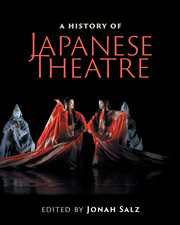Book contents
- Frontmatter
- Contents
- List of figures
- List of tables
- Contributors
- Contributors’ biographies
- Foreword
- Acknowledgments
- Note on Japanese terms
- List of abbreviations
- Timeline
- Editor's introduction
- I Traditional theatres
- Preface to Part I Japanese civilization arises
- 1 Ancient and early medieval performing arts
- Interlude Katari narrative traditions: from storytelling to theatre
- 2 Noh and Muromachi culture
- Interlude Noh and kyogen costumes and masks
- 3 Kyogen: classical comedy
- Interlude Iemoto : the family head system
- 4 Kabuki: superheroes and femmes fatales
- Interlude Nihonbuyo: classical dance
- Interlude Okinawan theatre: boundary of Japanese theatre
- 5 Bunraku: puppet theatre
- Interlude Misemono and rakugo : sideshows and storytelling
- Interlude Kamigata geinō : Kyoto-Osaka style
- Interlude Traditional theatre tomorrow: interview with Takemoto Mikio
- II Modern theatres
- Preface to Part II
- III Arcs and patterns
- IV Theatre architecture
- Preface to Part IV Evolution of Japanese theatre architecture
- V Theatre criticism
- VI Intercultural influences
- Epilogue: Frozen words and mythology
- Further reading
- Index
- References
Interlude Misemono and rakugo : sideshows and storytelling
from Preface to Part I Japanese civilization arises
Published online by Cambridge University Press: 05 July 2016
- Frontmatter
- Contents
- List of figures
- List of tables
- Contributors
- Contributors’ biographies
- Foreword
- Acknowledgments
- Note on Japanese terms
- List of abbreviations
- Timeline
- Editor's introduction
- I Traditional theatres
- Preface to Part I Japanese civilization arises
- 1 Ancient and early medieval performing arts
- Interlude Katari narrative traditions: from storytelling to theatre
- 2 Noh and Muromachi culture
- Interlude Noh and kyogen costumes and masks
- 3 Kyogen: classical comedy
- Interlude Iemoto : the family head system
- 4 Kabuki: superheroes and femmes fatales
- Interlude Nihonbuyo: classical dance
- Interlude Okinawan theatre: boundary of Japanese theatre
- 5 Bunraku: puppet theatre
- Interlude Misemono and rakugo : sideshows and storytelling
- Interlude Kamigata geinō : Kyoto-Osaka style
- Interlude Traditional theatre tomorrow: interview with Takemoto Mikio
- II Modern theatres
- Preface to Part II
- III Arcs and patterns
- IV Theatre architecture
- Preface to Part IV Evolution of Japanese theatre architecture
- V Theatre criticism
- VI Intercultural influences
- Epilogue: Frozen words and mythology
- Further reading
- Index
- References
Summary
In the early modern era commoners could enjoy myriad forms of entertainment besides kabuki and bunraku, for a fraction of the price. Prior to the nineteenth century these tended to be outdoor spectacles, including non-theatrical attractions such as mechanized dolls (karakuri ningyō) that performed fascinating tricks, and booths featuring Dutch imports such as microscopes to examine things like fleas and lice, and “seven-faced mirrors” showing viewers’ faces hilariously distorted. Storytelling employing properties and music also became especially popular in the course of the Edo period (1603–1868).
Misemono sideshow attractions
Religious or folk “street arts” (daidō gei) presented at temple festival grounds or crossroads since the medieval age gave birth to Edo period misemono (見世物, lit. “things for showing”). These innumerable inexpensive acts and attractions were presented by amateurs or professionals outdoors, or in small tents or shacks (koya) erected temporarily on temple and shrine grounds, or more permanently in the market areas of towns such as Ryōgoku in Edo (present-day Tokyo), or Osaka's Sen'nichi-mae. While certain sideshows developed into sophisticated performance traditions, countless others were amateurish or hoaxes, short-lived and forgotten. A small admission fee gained one access to view an exotic person, creature, object, or act. Instead of a cover charge, sometimes tips were solicited; traveling peddlers used such attractions to lure customers to their wares.
Misemono included magic tricks, acrobatics, top-spinning stunts, balancing acts, feats of strength, dance, martial arts, and other entertainments. There were also “freaks of nature,” people with handicaps and deformities, unusual beasts (camels, elephants), insects and fish, plants, trees, and stones. Exhibitions of sophisticated craftsmanship could also be found, such as papier mâché puppets, mechanical apparatus, glasswork, basketwork, shellwork, and chrysanthemum art (weaving). Misemono were aimed at general audiences, but there were also misemono specifically for adults. Sexual misemono were officially banned in the early Meiji period (1868–1912), but could be found well into the 1920s. Today misemono can still be seen at local festivals and street corners, some absorbed into variety hall (yose) sideshow acts (iromono). Some flea market or door-to-door food vendors still perform entertaining lines of narrative or songs, or strike out rhythms with their hands or cooking utensils.
- Type
- Chapter
- Information
- A History of Japanese Theatre , pp. 184 - 189Publisher: Cambridge University PressPrint publication year: 2016
References
- 1
- Cited by



